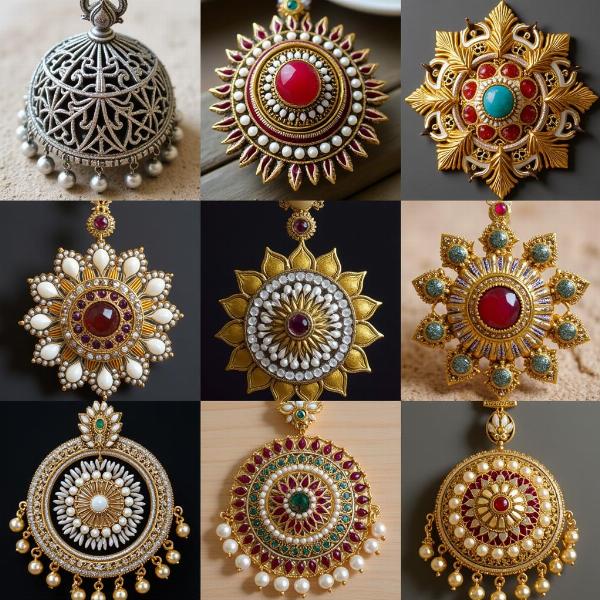Pajeb, a word steeped in tradition and cultural significance, often piques the curiosity of those exploring Hindi and Indian culture. Understanding its meaning goes beyond a simple translation; it delves into the rich tapestry of Indian customs, particularly concerning marriage and adornment. This article aims to provide a comprehensive understanding of “pajeb meaning in Hindi,” exploring its various facets and related concepts.
Unveiling the Significance of Pajeb in Indian Culture
Pajeb, also commonly spelled as “payal,” refers to anklets in Hindi. These ornaments, typically made of silver or gold, are worn by women around their ankles. More than just a piece of jewelry, pajeb holds symbolic meaning, often associated with marital status and femininity. The gentle jingling sound they produce is considered auspicious and believed to ward off negative energy.
Different Types and Designs of Pajeb
The artistry of pajeb making is diverse, with various regional styles and designs reflecting the rich cultural heritage of India. From simple, thin chains to elaborate, heavily ornamented pieces, pajeb caters to different tastes and occasions. Some popular designs include:
- Plain Silver Pajeb: A classic and timeless choice, often preferred for everyday wear.
- Gold Pajeb: A symbol of prosperity and elegance, usually worn during special occasions and weddings.
- Kundan Pajeb: Intricately designed with precious stones and gold, representing royalty and grandeur.
- Meenakari Pajeb: Enameled anklets with vibrant colors and delicate patterns, popular in Rajasthan.
 Different Pajeb Designs and Metals
Different Pajeb Designs and Metals
The Cultural Significance of Pajeb in Weddings
Pajeb plays a particularly important role in Indian weddings. It’s an essential part of the bridal trousseau, symbolizing her new status as a married woman. The sound of the pajeb is believed to announce the arrival of the new bride in her husband’s home. In some cultures, the pajeb is also seen as a symbol of fertility and prosperity for the newlywed couple.
Pajeb in Literature and Folklore
Pajeb has been a recurring motif in Indian literature and folklore, often used to describe a woman’s grace and beauty. The jingling sound is often romanticized and associated with the delicate footsteps of a woman. Many traditional songs and poems mention pajeb, further cementing its place in Indian culture.
What does the sound of Pajeb symbolize?
The tinkling sound of pajeb is not just pleasing to the ear; it’s believed to have a deeper meaning. Traditionally, the sound is thought to ward off evil spirits and attract positive energy. It’s also associated with the goddess Lakshmi, the goddess of wealth and prosperity.
Are there any specific rituals associated with wearing Pajeb?
While there are no specific rituals universally followed, in some communities, the mother-in-law gifts the bride a pair of pajeb as a blessing. This gesture signifies the bride’s acceptance into the family.
Pajeb: A Timeless Tradition
Pajeb continues to be a cherished piece of jewelry for Indian women, transcending generations. While its designs and styles evolve with time, the underlying symbolism and cultural significance remain intact, making it a timeless tradition.
Conclusion
Understanding “pajeb meaning in Hindi” provides a glimpse into the intricate cultural landscape of India. From its symbolic representation in weddings to its presence in literature and folklore, pajeb holds a significant place in the hearts of Indian women. It’s more than just an ornament; it’s an embodiment of tradition, beauty, and cultural heritage.
FAQ
- What is the difference between pajeb and payal? Pajeb and payal are essentially the same, referring to anklets. They are simply different spellings of the same word.
- Can unmarried women wear pajeb? Yes, unmarried women can wear pajeb. While traditionally associated with marriage, it is now commonly worn by women of all ages and marital statuses.
- What is the significance of silver pajeb? Silver is considered auspicious in Indian culture and is believed to have healing properties. Silver pajeb is often preferred for daily wear due to its perceived health benefits.
- Where can I buy authentic pajeb? Authentic pajeb can be purchased from jewelry stores specializing in Indian jewelry, both online and offline.
- What are some modern interpretations of pajeb? Modern pajeb designs incorporate contemporary elements like gemstones, minimalist styles, and unique patterns, catering to evolving fashion trends.
Connect with Meaning-Hindi.in for Expert Translation Services
Meaning-Hindi.in is your one-stop solution for all your Hindi translation needs. We offer a wide range of professional translation services, specializing in business, legal, technical, website localization, educational, and specialized translations. Our team of expert linguists ensures accurate and culturally sensitive translations, bridging the language gap between Hindi and other languages. Whether you need a document translated quickly or require specialized translation services, Meaning-Hindi.in is here to assist you. Contact us today at [email protected] or call us at +91 11-4502-7584 to discuss your translation requirements. Let Meaning-Hindi.in help you communicate effectively and achieve your global goals.